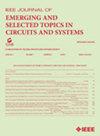DND: Deep Learning-Based Directed Network Disintegrator
IF 3.7
2区 工程技术
Q2 ENGINEERING, ELECTRICAL & ELECTRONIC
IEEE Journal on Emerging and Selected Topics in Circuits and Systems
Pub Date : 2023-06-28
DOI:10.1109/JETCAS.2023.3290319
引用次数: 0
Abstract
Network disintegration is a fundamental problem in network science, the core of which is how to determine the smallest set of nodes whose removal can weaken the function of the network and quickly paralyze it. It is computationally NP-hard and usually cannot be solved in polynomial time complexity. Many network disintegration methods have been proposed, but they mainly focus on undirected networks. Due to the complex structure of directed networks and the fact that it is necessary to consider the direction of edges to aggregate neighbor node information, solving the disintegration problem of directed networks is a challenge. Inspired by machine learning technology to solve the network disintegration problem, this paper studies feasible disintegration methods in directed networks and proposes a deep learning-based framework, DND (directed network disintegrator), for directed network disintegration, which has a small time complexity when dismantling large directed networks. DND can be trained in small, artificially generated synthetic directed networks and then applied to real-world, complex application scenarios. To test the disintegration effect of DND, we conducted extensive experiments on different types of synthetic directed networks and compared them with other methods. The experimental results show that the disintegration effect of DND is weaker than the CoreHD method, and better than the disintegration method based on local structural features, but the disintegration speed is the fastest with the increase in network size. We also disintegrate directed networks in the real world, and DND achieves a better disintegration effect, providing new insights into solving complex network-related problems and enabling us to design more robust networks to withstand attacks and failures.DND:基于深度学习的定向网络分解器
网络解体是网络科学中的一个基本问题,其核心是如何确定最小的节点集,这些节点的移除可以削弱网络的功能并使其迅速瘫痪。它在计算上是np困难的,通常不能用多项式时间复杂度来解决。人们提出了许多网络分解方法,但它们主要集中在无向网络上。由于有向网络结构复杂,需要考虑边的方向来聚集相邻节点信息,解决有向网络的解体问题是一个挑战。受机器学习技术解决网络分解问题的启发,本文研究了有向网络中可行的分解方法,提出了一种基于深度学习的有向网络分解框架DND (directed network disintegrator),该框架在分解大型有向网络时具有较小的时间复杂度。DND可以在人工生成的小型合成定向网络中进行训练,然后应用于现实世界的复杂应用场景。为了测试DND的瓦解效果,我们对不同类型的合成定向网络进行了广泛的实验,并与其他方法进行了比较。实验结果表明,DND的分解效果弱于CoreHD方法,优于基于局部结构特征的分解方法,但随着网络规模的增加,分解速度最快。我们还对现实世界中的有向网络进行了分解,DND实现了更好的分解效果,为解决复杂的网络相关问题提供了新的见解,使我们能够设计出更健壮的网络来抵御攻击和故障。
本文章由计算机程序翻译,如有差异,请以英文原文为准。
求助全文
约1分钟内获得全文
求助全文
来源期刊

IEEE Journal on Emerging and Selected Topics in Circuits and Systems
ENGINEERING, ELECTRICAL & ELECTRONIC-
CiteScore
8.50
自引率
2.20%
发文量
86
期刊介绍:
The IEEE Journal on Emerging and Selected Topics in Circuits and Systems is published quarterly and solicits, with particular emphasis on emerging areas, special issues on topics that cover the entire scope of the IEEE Circuits and Systems (CAS) Society, namely the theory, analysis, design, tools, and implementation of circuits and systems, spanning their theoretical foundations, applications, and architectures for signal and information processing.
 求助内容:
求助内容: 应助结果提醒方式:
应助结果提醒方式:


